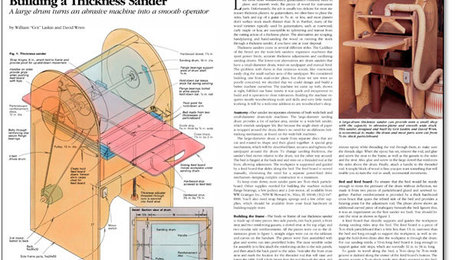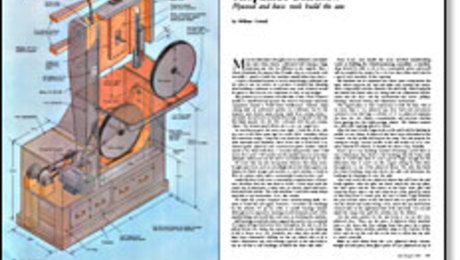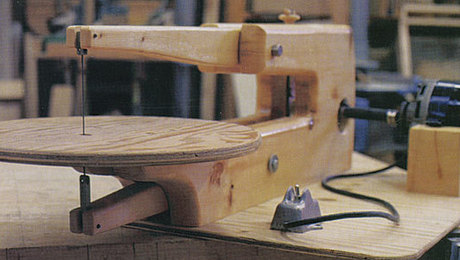Jeremy Fielding’s shopmade machines
From CNC controlled tablesaws to variable speed miter saws, Jeremy Fielding uses woodworking as a great excuse to build some incredible machines.Different woodworkers focus on different aspects of woodworking. It’s only natural that what works for you might not work for me, and what is important to you, might not be important to me. It takes all kinds, and there is room for everyone in this wonderful craft. If you’re the kind of woodworker who becomes triggered by the mere mention of CNC technology, stop reading and certainly don’t hit play on the video above. However, if you like to see people using their talents to make cool semi-robotic woodworking tools, Jeremy Fielding is worth a subscribe on YouTube.
Jeremy might be familiar to some of you, as he is frequently featured on Destin Sandlin’s wildly popular YouTube channel, Smarter Every Day. (If you’re not familiar with Smarter Every Day, you should check it out. My 7-year old son and I watch every single video with the same amount of enthusiasm.) One day, while traveling down the YouTube rabbet hole, I found Jeremy’s channel. I’ve been an avid watcher ever since. Jeremy is obviously an exceptional engineer, but much to my surprise he’s a prolific woodworker as well. In fact, he’s married the two passions in a very productive way and has made and/or modified almost all of the tools in his woodworking shop. “There are very few tools in my shop I haven’t modified. Perhaps my drills and things like my orbital sander. About two-thirds are built from scratch by me, and nearly all the rest have been modified significantly.”
Jeremy’s automated blast gates inspired him to rework his whole dust-collection system.
For woodworkers who are also tinkerers and want to try building or modifying their own tools, I asked Jeremy where would be a good place to start. Not surprisingly, Jeremy recommends starting simple, with something like a disc sander. “Years ago I made a combination disc/belt sander because I couldn’t find one that met my needs. I didn’t want to buy two separate machines because of space constraints at the time. Thus, I made one mostly out of wood. I used a motor from a broken washing machine. It worked well and cost little in terms of dollars spent.”
An engineer by trade–self taught by the way–building his own machinery comes naturally to Jeremy. He relishes designing and building the machines he uses for woodworking, and can’t imagine buying them. “For me it’s a hobby, so the time invested is good. Asking me to buy a machine is like asking a man who goes fishing every weekend to buy fish at the store. He would much rather catch it himself. Sure, one saves a lot of time, but that’s not why he goes fishing. I enjoy making the tools as much or more than the things I eventually make with the tools.”
A true maker and self proclaimed tinkerer, Jeremy decided to modify his chopsaw by powering it with a 3-phase motor and VFD:
I asked him if it’s difficult to switch between the mindset of an engineer by day and a woodworker by night. For Jeremy, they are one and the same–there’s just a different set of tolerances. “The engineering mindset is what drives me to make. I use wood based on its properties just like any other material. However, wood is probably my favorite material because it is so cost effective to buy, can be cut with cheap tools, and is readily available. If I must measure any part in thousandths of an inch for it to fit, I feel as though I have failed in the design process. Tight tolerances increase the cost and time required to make a part. That is something I fight against on every project both at work and in my personal projects. It should be just enough to do the job and meet the budget. There were many places I could have made my CNC tablesaw more precise with a different rail system, servo motors, and higher end electronics. It would have improved my tolerances by 3-4%, but would have increased the cost by more than 50%.”
Jeremy has over 370,000 YouTube subscribers, so I’m obviously not the only one who has benefited from the time he has taken to post his builds to YouTube. I asked Jeremy if he’d be as likely to build his machinery if it wasn’t serving to educate such a large audience. “I would definitely continue to make my own tools without YouTube. In fact, it would be easier if I wasn’t trying to document the whole process with a camera and explain what was happening.”
I, for one, am glad that he is documenting his work for the world to learn from. In fact, without Jeremy’s channel, there is no chance I’d be able to comprehend exactly what 3-phase power does, and why you should always grab a treadmill off the side of the road… for parts to make cool machines out of!
 |
|
 |
Shopmade BandsawPlywood and basic tools built the saw |
 |






















Comments
Jeremy is brilliant! I am blown away with the automation he has accomplished with his tablesaw. The presentation is very clear, concise, and informative.
Hey Ben! I've been following Jeremy for a while now. I spent my career as an engineer doing stuff much like this. Thanks for showcasing this guy. He is inspiring. Now I've gotta figure out how to mount this stepper motor to my jointer...
Don't ask me, I'm still trying to figure out where to put an arduino on my bevel-up jack plane!
“[Deleted]”
I hollowed out the tote on my Veritas #5 LA jack. Batteries in the handle, and you're good to go!
If you will continue cutting in that way, your belt and pulleys worn too badly and later you will trash them. At the end of your experiments you also put your expensive cutting disk into trash bin.
Good find Ben. Jeremy is extremely interesting and entertaining without being over the top obnoxiously high energy.
Rust Bullet Metal Blast on amazon for 20.00 Works in 10 minutes.
That was fun to watch. Thanks for raising awareness about Jeremy.
Log in or create an account to post a comment.
Sign up Log in